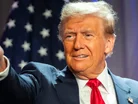The Trump Tariffs: Pros, Cons & Global Impact

Donald Trump is a polarising figure who consistently endorses the America First agenda. During his election campaign, he frequently touted tariffs as a critical tool to protect US interests.
Calling them his "favourite word in the dictionary," Trump pledged to impose significant tariffs on Mexico, Canada, and China upon taking office, with the potential for their impact to expand globally over time. The tariffs, which came to be known as the 'Trump Tariffs', have sparked heated debate over their benefits and drawbacks.
What are the potential pros of the Trump Tariffs?
Protecting American industries
One of the most frequently cited advantages of tariffs is their potential to shield domestic industries from foreign competition. Taxing imports allows American consumers to buy domestically produced goods, potentially preserving jobs in key sectors.
Increasing federal revenue
Tariffs provide an additional revenue stream for the US government. As importers pay duties on foreign goods, the federal treasury benefits from these payments, creating a short-term economic boost.
Encouraging domestic manufacturing
Supporters argue that tariffs incentivise companies to manufacture goods in the United States. By raising the cost of imported goods, businesses may find it more cost-effective to keep operations within national borders, bolstering supply chain resilience and contributing to national security.
What are the potential cons of the Trump Tariffs?
Higher consumer prices
One of the most immediate impacts of tariffs is a rise in consumer prices. Goods ranging from electronics like laptops and smartphones to everyday groceries may see significant price hikes. Economists have noted that tariffs can reduce the US GDP by as much as 0.64%.
While Trump and his supporters contend that previous tariffs didn't dramatically increase inflation, most experts disagree, asserting that consumers typically bear the brunt of these policies.
Global economic slowdown
The ripple effects of tariffs are not confined to the US. Economists project that China could experience a GDP decline of 0.68%, while the EU might see a drop of 0.11%. These reductions highlight how tariffs can disrupt global trade and hinder economic growth across borders.
"The higher the tariff, the more likely it is the company will come into the United States and build a factory."
Inflation and interest rate concerns
Tariffs may contribute to inflationary pressures by driving up the cost of goods. In response, central banks could raise interest rates, potentially slowing economic growth and increasing borrowing costs for businesses and consumers.
Supply chain disruption
Modern industries rely heavily on global supply chains; tariffs threaten to upend this balance. Higher costs and logistical challenges could disrupt technological, automotive and retail production.
Retaliatory trade wars
The most significant risk is the potential for a trade war. Countries impacted by US tariffs could retaliate with their own measures, escalating tensions and causing further economic harm.
Countries most affected by Trump Tariffs
- China: Additional 10% tariffs on Chinese goods during Trump's first presidency reduced its GDP by an estimated 0.68%.
- Mexico: A proposed 25% tariff on Mexican imports would severely harm its economy, as the US is its largest trading partner.
- Canada: Facing a similar 25% tariff, Canada's economy would be hit hard, given that 75% of its exports go to the US.
- European Union: While only sometimes directly targeted, the EU, particularly Germany, could face significant losses due to its reliance on exports, especially in the automotive sector.
The impact on EVs
Tariffs have raised concerns about hindering the adoption of EVs in the US.
- Higher costs for imported components may slow production and discourage consumers from transitioning to more sustainable transport options. Companies like Tesla, General Motors and Rivian, among others, have been expanding EV production in the US, but cost increases could hamper these efforts.
Trump's legacy on trade
By the end of Trump's presidency in 2021, tariffs had been applied to US$370bn worth of Chinese goods. While the Biden administration has made some modifications, these measures remain in place.
As Trump once declared, "Trade wars are good and easy to win," reflecting his belief in tariffs as a core element of his economic strategy.
The debate over the Trump Tariffs highlights their polarising nature. While they aim to protect American interests, their broader economic implications highlight the complex interplay between national policies and global markets.
Explore the latest edition of EV Magazine and be part of the conversation at our global conference series, Sustainability LIVE and Manufacturing LIVE.
Discover all our upcoming events and secure your tickets today.
EV Magazine is a BizClik brand


